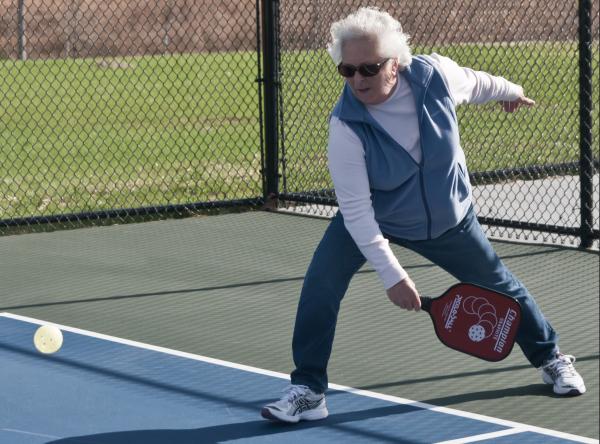A recent article in MedPage Today looked at eye injuries from pickleball, the most addictive sport ever. In fact, I'll go a little further. Addiction potential: Pickleball >> heroin > alcohol > Vicodin = Game of Thrones. It's so addictive that in 2022, 36.5 million people -- 14% of all Americans over 18 – played the game. By comparison, a measly 23 million people played tennis. (For those of you who have absolutely nothing going on in your life perhaps you'd like to waste your time on A Demented Pickleball Chemistry Lesson, which I wrote in 2023.)
This game is not just a passing fad. At a certain age or condition, sports like basketball and tennis become difficult, if not impossible, to play. There is just a lot of area to cover for people with bad knees, ankles, spines, spleens, etc. Pickleball didn't overtake tennis simply because it was more fun and easier to play. It provides an opportunity for old coots such as myself to get back to playing a racquet sport (I gave up tennis 10 years ago because of injuries but can play pickleball three times per week without needing morphine. At least, not very much.)
Pickleball = Injuries
While the sport is great for otherwise inactive seniors it brings with it a set of risks, which we must accept if we're going to play. The game has been called "The Orthopedic Surgeon's Best Friend," which makes plenty of sense. Any stop-and-start, fast-moving sport, no matter how much you work out or stretch, is going to result in torn Achilles tendons, hamstring, groin and calf injuries, etc. These are "acceptable," if not inevitable. But severe eye injuries are neither.
Pickleball eye injuries can be serious
Older people – the majority of players are older than 60 – who either never played or can no longer play, tennis are flocking to the game in huge numbers. This is crazy ----> An average of 30 pickleball courts are being built every day in the US. Any sport that brings seniors back into the world of athletics is good news but with a caveat: Seniors are most likely to sustain serious eye injuries, which has prompted me to take action, as shown in the following photo – one that I will surely regret.

(Left) The J-Man, looking like a flaming jackass, during a recent pickleball lesson. I should note that all of that equipment is legitimate and was used in the lesson, but not as pictured. (Right) Bad-ass NoCry Pickleball Goggles. $15-20 on Amazon and well worth it.
Two factors primarily make eye injuries a real concern: 1) Most of the game is played near the net; 2) The court is small. Pickleball courts are 20 by 44 feet, compared to tennis courts, which are 36 by 78 feet (1) – more than three times the area. Worse still, the distance between players at the net can be as little as 14 feet (2), giving the players (especially those with slower reflexes) very little time to react. So, if some BMF (B = big) launches one at your face from 14 feet away you're a sitting pickle. One pickleball site tells us:
Most volleys at the kitchen line [the closest you are allowed to get to the net] are somewhere between 30-40 mph. The reaction time at the non-volley zone would be approximately .24 of a second.
It's not just distance: Ball size
Andrew G. Lee, MD, of Baylor College of Medicine and Houston Methodist Hospital, recently told MedPage Today:
"The smaller a ball is, the more it can fit into the eye socket without hitting the bone. That's why smaller balls like racquetballs and squash balls are actually more likely to cause direct eye injury than tennis balls, footballs, or baseballs, which are bigger."
Because of the speed with which the sport has caught on it is difficult to quantify the number of current eye injuries. Rather than focus on data from journal publications (3), which won't be known for years, let's look at an article by Minnesota Eye Consultants. It is eye-opening (sorry):
"As you can imagine, many of the eye injuries we see may require surgery depending on the severity. Here are some of the injuries and procedures that have been performed at Minnesota Eye Consultants as a result of pickleball trauma":
- using sutures to repair eyelid and brow lacerations
- dislocation of the natural lens, often requiring a new lens and cataract extraction
- damage to the pupil, resulting in the need to suture the pupil smaller
- replacing a damaged iris with an artificial iris
- retinal detachment, leading to retinal surgery
- total loss of an eye, requiring surgical removal
You don't need to be a mathematical prodigy to realize that if a single clinic in Minnesota has replaced damaged irises, repaired detached retinas, and surgically removed eye(s), the nationwide total of serious eye injuries must be seriously undercounted at the present time.
Bottom Line
Dear Fellow Old Folks, it's fine if you put on your knee, elbow, and wrist braces before going into battle but the only essential piece of equipment is the goggles. This game is not tennis, where you at least have a little time to get out of the way of a hard shot or overhead slam. In pickleball, a ball in the eye comes out of nowhere and if it's "on target" there is little you can do about it in 0.24 seconds.
1) Stretch. 2) Goggles on. 3) Go get 'em.
NOTE:
(1) That is the dimension of a doubles court in tennis. A singles court is 27 X 38 feet.
(2) There is a seven-foot area adjacent to the net (called "the kitchen" where (except in certain situations) you are not allowed to enter. This is why players can be as close to 14 feet from each other across the net.
(3) There is a recent article in Nature. It is focused on case studies.




